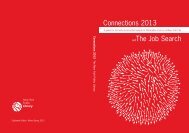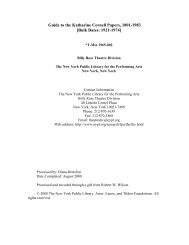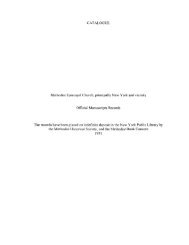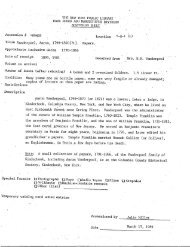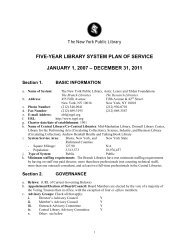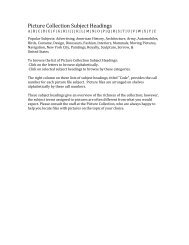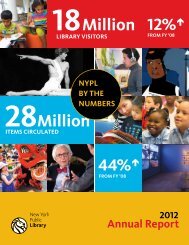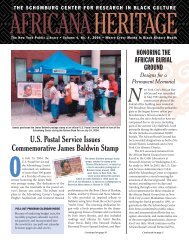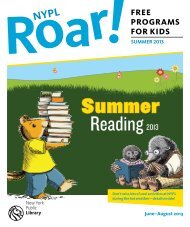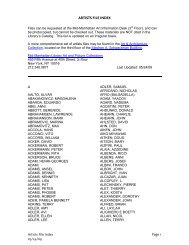Neighborhood Guide: The Lower East Side - New York Public Library
Neighborhood Guide: The Lower East Side - New York Public Library
Neighborhood Guide: The Lower East Side - New York Public Library
You also want an ePaper? Increase the reach of your titles
YUMPU automatically turns print PDFs into web optimized ePapers that Google loves.
: : NEW YORK NEIGHBORHOODS : : THE LOWER EAST SIDE : : : : NEW YORK NEIGHBORHOODS : : THE LOWER EAST SIDE : :<br />
<strong>The</strong> <strong>Lower</strong> <strong>East</strong> <strong>Side</strong> of <strong>New</strong><br />
<strong>York</strong> City is a neighborhood<br />
of constant change, within<br />
which one can find the<br />
impact of local, national, and<br />
international historical events.<br />
Located on the southern and eastern side of Manhattan,<br />
close to the <strong>East</strong> River and Port of <strong>New</strong> <strong>York</strong>, the<br />
neighborhood developed early into an area that<br />
housed new immigrant groups, many of which started<br />
their American life there. <strong>The</strong> story of immigration in<br />
this neighborhood is richly textured, with immigrant<br />
groups overlapping, supplanting each other, and<br />
contributing to the character and face of the city.<br />
This immigration story also reveals prejudice and<br />
obstacles; the creation of social and cultural legacies;<br />
the positive and negative impacts of social reform;<br />
conflict and cohesion; persistence; hope; and, at times,<br />
devastating tragedy.<br />
Although the neighborhood is best known for its links<br />
to the immigration story, the <strong>Lower</strong> <strong>East</strong> <strong>Side</strong> has also<br />
been influenced by events more common to the city<br />
as a whole. Identified as a “slum” from the start, the<br />
neighborhood was often seen as a place that needed<br />
improvement. As historian David Ward writes, “the<br />
slum has been an evocative and durable description of<br />
the squalid environs and pathological social conditions<br />
of the residential quarters of the poor.” For this reason,<br />
reforms in housing, education, and health were enthusiastically<br />
applied to the <strong>Lower</strong> <strong>East</strong> <strong>Side</strong>.<br />
Housing development greatly changed the face of this<br />
neighborhood in the late-19th and the 20th centuries<br />
as <strong>New</strong> <strong>York</strong> City struggled to accommodate a growing<br />
population and contend with “slum clearance” mandates.<br />
As is true in most urban areas, the demolition<br />
of old buildings in favor of new development caused<br />
conflict. For the slums to be cleared and cleaned up,<br />
populations had to be displaced. This scenario played<br />
itself out on the <strong>Lower</strong> <strong>East</strong> <strong>Side</strong> and created different<br />
perspectives on the issue, yielding a variety of results.<br />
This was also the case of sanitation and education<br />
reforms, which many historians argue forced new<br />
immigrants to Americanize quickly and thus abandon<br />
their original cultural heritage.<br />
<strong>The</strong> following guide is meant to aid in a study of the<br />
nation’s story of immigration, in an examination of<br />
<strong>New</strong> <strong>York</strong> City history, or as a neighborhood case<br />
study. <strong>The</strong> goal of the guide is to supplement these<br />
narratives with the rich collections of <strong>The</strong> <strong>New</strong> <strong>York</strong><br />
<strong>Public</strong> <strong>Library</strong>, and to bring to light new resources<br />
for teaching these topics. All of the resources in the<br />
guide can be found in the magnificent collections of<br />
<strong>The</strong> <strong>New</strong> <strong>York</strong> <strong>Public</strong> <strong>Library</strong>. <strong>The</strong> guide is organized<br />
thematically to focus on turning points in the history<br />
of the <strong>Lower</strong> <strong>East</strong> <strong>Side</strong> as they relate to local, national,<br />
and international events. It is primarily chronological,<br />
with some thematic sections overlapping in time. Each<br />
thematic section has a short introduction, followed<br />
by a collection of primary sources, their provenances,<br />
methods for interpretation, and suggested activities<br />
and resources.<br />
For more information on this or other related topics,<br />
you can search NYPL collections at www.nypl.org.<br />
Ward, David. “<strong>The</strong> Victorian Slum: An Enduring Myth?”<br />
Annals of the Association of American Geographers<br />
Vol. 66, No. 2 (June, 1976), pp. 323–336.<br />
How To Use This <strong>Guide</strong><br />
Essential Questions to <strong>Guide</strong> a Unit of Study<br />
<strong>The</strong> artifacts in this guide include a variety of prints,<br />
photographs, maps, and excerpts from manuscripts<br />
all found in the remarkable collections of <strong>The</strong> <strong>New</strong><br />
<strong>York</strong> <strong>Public</strong> <strong>Library</strong>. <strong>The</strong>se resources are organized<br />
into themes that reflect historical moments associated<br />
with the <strong>Lower</strong> <strong>East</strong> <strong>Side</strong> of <strong>New</strong> <strong>York</strong>, as well as<br />
more general themes in <strong>New</strong> <strong>York</strong> City and American<br />
history. As you go through this guide, it is useful<br />
to keep the following Essential Questions in mind:<br />
• What are the patterns of city growth?<br />
• How and why do cities change over time?<br />
• How can images and text illuminate the story<br />
of city change over time?<br />
• Are changes that occur in cities consciously<br />
or unconsciously created?<br />
• What is the most important role of a<br />
neighborhood?<br />
How to Make the Most of This <strong>Guide</strong><br />
Each section of this guide focuses on a particular<br />
theme associated with the growth of the <strong>Lower</strong> <strong>East</strong><br />
<strong>Side</strong>. A historical overview introduces every section; it<br />
is followed by a few suggested activities and a series of<br />
primary sources from the NYPL collection illustrating<br />
each topic. A sequence of leveled questions is provided<br />
for every source in the guide. In a few instances,<br />
sources are grouped and share a set of questions<br />
(see Sections 2, 5, and 6).<br />
Along with the specific suggestions and questions<br />
found in each section, we have also provided more<br />
general lesson activities that can be used for a critical<br />
inquiry of primary sources. <strong>The</strong>se activities include<br />
methods for making observations and drawing inferences,<br />
comparing and contrasting documents, and<br />
developing connections between sources. <strong>The</strong>se<br />
general activities can be used throughout this guide<br />
and can be adapted for use in groups, by different<br />
age levels, and to differentiate materials for instruction.<br />
<strong>The</strong>se lesson suggestions are included in the<br />
following segment.<br />
All of the images in this guide can be found on the<br />
accompanying CD, which can be displayed on a Smart<br />
Board or used with an LCD projector. You can also<br />
print images from the CD to use with your class.<br />
ACTIVITY SUGGESTIONS FOR<br />
RESOURCE ANALYSIS<br />
Observation/Inference Chart<br />
This activity helps students practice observations<br />
before drawing conclusions. It helps students to<br />
slow down their thinking so that they can base their<br />
opinions on facts. It builds on the observations and<br />
analysis of a large group, thus helping students to see<br />
the benefits of hearing others’ perspectives on a topic.<br />
It can also serve as an excellent jumping off point for<br />
generating questions.<br />
This exercise works best with a visual document.<br />
Project one of the images from the CD onto the Smart<br />
Board or use with the LCD projector. Using a simple<br />
chart (Graphic Organizer 1, p. 6), ask students to look<br />
at the document and write down their observations.<br />
<strong>The</strong>y should categorize them into “observations”<br />
(facts) and “inferences” (opinions based on what they<br />
observe). Observations are something that all viewers<br />
can agree on. Inferences are particular to the viewer<br />
and reflect the viewer’s beliefs and experiences. After<br />
approximately 10 minutes, ask students to share their<br />
observations and inferences in a round-robin manner.<br />
You can ask students to clarify their inferences by asking,<br />
“What did you see that makes you say that?” After<br />
gathering the class’s observations and inferences, you<br />
can discuss: What more did we see in the document as<br />
we went along? What themes were raised? What new<br />
questions were asked? Did hearing other observations<br />
make you see the document differently? Are all of the<br />
observations truly factual?<br />
Compare and Contrast<br />
Choose two or three resources from the guide that you<br />
think lend to an interesting comparison. Students will<br />
compare and contrast these resources using a Venn<br />
Diagram (Graphic Organizers 2 and 3, p. 7). Look for<br />
differences in materials, points of view, representa-<br />
2 3




